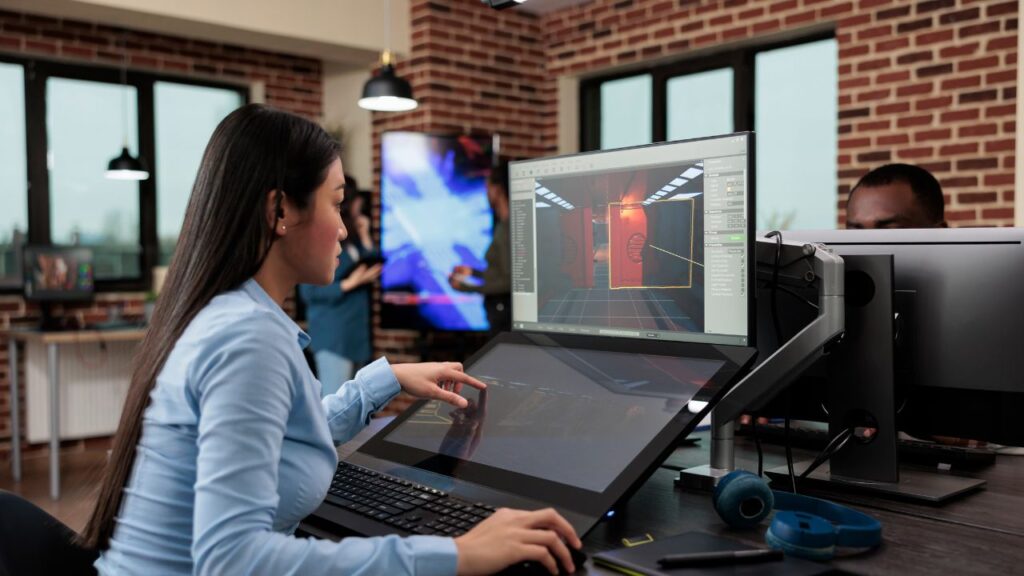Making mobile games used to require years of programming experience and complex coding skills. Many creative people had amazing game ideas but felt stuck because they couldn’t write code. This left countless potential game developers on the sidelines, watching others create the games they dreamed of making.
Anyone can now create professional mobile games without writing a single line of code, thanks to modern no-code game development platforms. These tools have changed everything for aspiring game creators. People can now focus on their creative vision instead of learning complex programming languages.
The process has become surprisingly simple and accessible. Creative individuals can design characters, build game worlds, and publish their games to app stores without technical barriers. This guide will show exactly how to get started with no-code mobile game development and take a game idea from concept to published app.
Why Should You Start Making Mobile Games Without Coding?
No-code game development platforms let anyone create mobile games using simple drag-and-drop tools and visual interfaces. Planning your game idea first and building quick prototypes helps turn your vision into reality without writing any code.
What Are the Best No-Code Game Development Platforms?
Several platforms make mobile game creation simple for beginners. GDevelop stands out as a free, open-source option that supports 2D, 3D, and multiplayer games. Users can publish their games on iOS, Android, Steam, and web platforms.
Construct 3 offers a browser-based editor with strong mobile export options. The platform includes built-in physics, behaviors, and effects that work well for mobile games.
GameSalad focuses specifically on mobile game creation. It provides templates and drag-and-drop tools designed for iOS and Android development.
Buildbox targets users who want to create games quickly. The platform emphasizes visual game creation without any scripting requirements.
Key factors to consider when choosing a platform:
- Publishing options (iOS, Android, web)
- Template availability for your game type
- Community support and tutorials
- Export limitations on free plans
- Learning curve difficulty
How Do Drag-and-Drop Interfaces Actually Work?
Drag-and-drop interfaces replace traditional coding with visual elements. Users select objects, behaviors, and actions from menus and place them directly into their game scenes.
Objects represent game elements like characters, backgrounds, and items. Users drag these from asset libraries onto the game screen. Each object can have multiple properties like size, color, and movement speed.
Behaviors control how objects act in the game. Common behaviors include:
- Platform movement for jumping characters
- Bullet behavior for projectiles
- Physics for realistic collisions
- Auto-rotate for spinning objects
Events create game logic through simple if-then statements. For example, “if player touches enemy, then reduce health by 1.” These events connect through visual flowcharts rather than code.
Actions define what happens when events trigger. Actions might play sounds, change scenes, or update score displays.
Most platforms use visual scripting where users connect nodes or blocks instead of writing text-based code. This approach makes complex game logic accessible to non-programmers.
How Should You Plan Your First Mobile Game?
Planning prevents common mistakes that waste time during development. Start with a simple game concept that focuses on one core mechanic. Popular beginner-friendly genres include puzzle games, endless runners, and tap-based games.
Define your target audience early. Kids prefer colorful, simple games while adults might enjoy strategy or word games. This choice affects art style, difficulty, and game length.
Create a one-page game design document that includes:
- Core gameplay in one sentence
- Art style description
- Target platform (iOS, Android, or both)
- Monetization plan (ads, in-app purchases, or paid)
- Success metrics (downloads, revenue, ratings)
Sketch your game screens on paper first. Draw the main menu, gameplay screen, and game over screen. This helps identify needed assets and user interface elements.
Research similar games on app stores. Note what players like and dislike in reviews. This research helps avoid common problems and identify successful features.
What Makes a Good Game Prototype?
Prototypes test core gameplay before investing time in graphics and polish. Focus on playable mechanics rather than beautiful visuals. Use simple shapes and placeholder graphics to represent game objects.
Test one feature at a time to identify problems quickly. If making a jumping game, create a basic character that can jump before adding enemies or obstacles.
Build prototypes in small iterations. Spend 2-3 days on each version, adding one new feature. This approach prevents overwhelming complexity and allows for quick testing.
Get feedback early from friends and family. Watch them play without giving instructions. Note where they get confused or frustrated. These observations reveal interface problems and unclear gameplay.
Document what works and what doesn’t. Keep notes about successful mechanics and failed experiments. This documentation helps when making design decisions later.
Test prototypes on actual mobile devices, not just computers. Touch controls feel different from mouse clicks. Screen size affects readability and button placement.
Set prototype goals before building. Common goals include testing core mechanics, checking performance, or validating art style. Clear goals prevent feature creep and keep development focused.
How Do You Create, Design, and Publish Your Mobile Game?
Building a mobile game involves creating visual assets, adding interactive elements, testing the game mechanics, and bringing your finished product to market. Each step uses simple tools that work without writing any code.
How Can You Design Game Art and Audio Assets Easily?
Most no-code game platforms include built-in asset libraries with ready-made graphics and sounds. These libraries contain sprites, backgrounds, characters, and sound effects that developers can use right away.
Many platforms offer drag-and-drop editors for customizing visual elements. Users can change colors, resize objects, and modify existing assets to match their game’s style.
Free external resources help expand creative options. Websites like Freepik and Pixabay provide additional graphics and audio files. These can be imported directly into most game development platforms.
The visual editor tools in platforms like GDevelop allow users to create simple animations. They can make characters move, objects rotate, and backgrounds scroll without any technical knowledge.
Audio integration works through simple upload features. Developers can add background music, sound effects, and voice recordings by selecting files from their computer.
What’s the Best Way to Add Interactivity and Game Logic Visually?
Visual scripting systems replace traditional coding with flowcharts and diagrams. Users connect blocks or nodes that represent different actions and events in their game.
Most platforms use event-based programming. This means developers set up rules like “when player touches enemy, lose one life” using simple dropdown menus and checkboxes.
Drag-and-drop interfaces make it easy to create game mechanics. Users can add jumping, shooting, collecting items, and scoring systems by connecting pre-made components.
Template systems provide starting points for common game types. Puzzle games, platformers, and arcade games come with basic logic already set up.
Real-time testing lets developers see changes immediately. They can adjust game speed, difficulty, and controls while the game is running.
How Do You Test and Debug Without Code?
Preview modes in no-code platforms let developers play their games instantly. This helps identify problems with controls, difficulty, or game flow right away.
Device simulators show how games will look on different screen sizes. Developers can test their games on various phone and tablet configurations without owning multiple devices.
Built-in debugging tools highlight common issues automatically. These tools point out missing assets, broken connections, or performance problems using simple error messages.
Community forums and help sections provide quick solutions. Other developers share fixes for common problems without requiring technical expertise.
Version control features let users save different versions of their games. This makes it safe to experiment with changes and go back if something breaks.
How Do You Launch and Market Your Mobile Game?
Export options in most platforms create files ready for app stores. Developers can generate builds for iOS App Store, Google Play Store, and other platforms with single clicks.
App store submission requires basic information like game descriptions, screenshots, and age ratings. Most platforms provide guides that walk through this process step by step.
Social media marketing helps reach potential players. Developers can share gameplay videos, screenshots, and development updates on platforms like TikTok and Instagram.
Gaming communities offer opportunities to showcase new games. Reddit, Discord, and specialized gaming forums let developers connect with interested players.
Influencer partnerships can boost visibility. Reaching out to gaming YouTubers or streamers who cover mobile games helps get more downloads and reviews.



